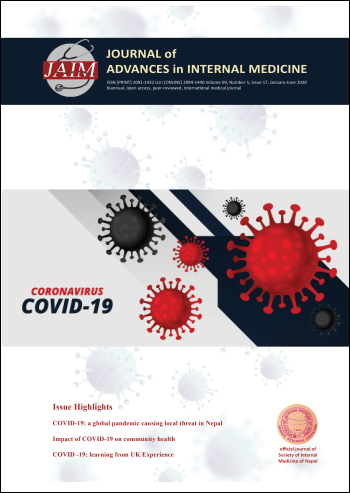COVID-19: Literature review and learning from UK Experience
DOI:
https://doi.org/10.3126/jaim.v9i1.29160Keywords:
COVID-19, Corona virus, PandemicAbstract
COVID19 (Corona virus disease 2019) is an illness caused by novel corona virus, first reported from Wuhan in China in December 2019. This pandemic has spread to most of the countries of the world and has already taken a huge human toll. Transmission is mostly by the respiratory droplets and also by fomites. While most infected individuals have mild symptoms, a small but significant proportion of individuals develop severe bronchopneumonia, sometimes leading to multiorgan dysfunction. Common symptoms are fever, cough, myalgia, fatigue, nausea, vomiting, diarrhoea, breathlessness etc. Diagnosis is made by clinical features in the right epidemiological setting, blood tests and usually confirmed by a PCR test with a nasopharyngeal and oropharyngeal swab. Management is mainly supportive as currently there is no proven antiviral treatment.
Reconfiguration of services was necessary to manage a large number of patients admitted to a UK hospital with COVID 19 disease as elective admissions were cancelled and hospital admissions due to due to other diseases significantly declined. Staff were reallocated to cope with the surge in hospital admissions. A system of training was put in place to upskill the staff. All but absolutely necessary outpatient consultations were done by telephone or videoconferencing.
COVID 19 patients were cared for in dedicated areas of the hospital and strict infection control procedures were followed. Intensive care unit facilities with ventilators were rapidly expanded with involvement of operation theatre areas. Non-invasive respiratory support was provided in respiratory wards.
Downloads
Downloads
Published
How to Cite
Issue
Section
License
This license enables reusers to distribute, remix, adapt, and build upon the material in any medium or format, so long as attribution is given to the creator.




